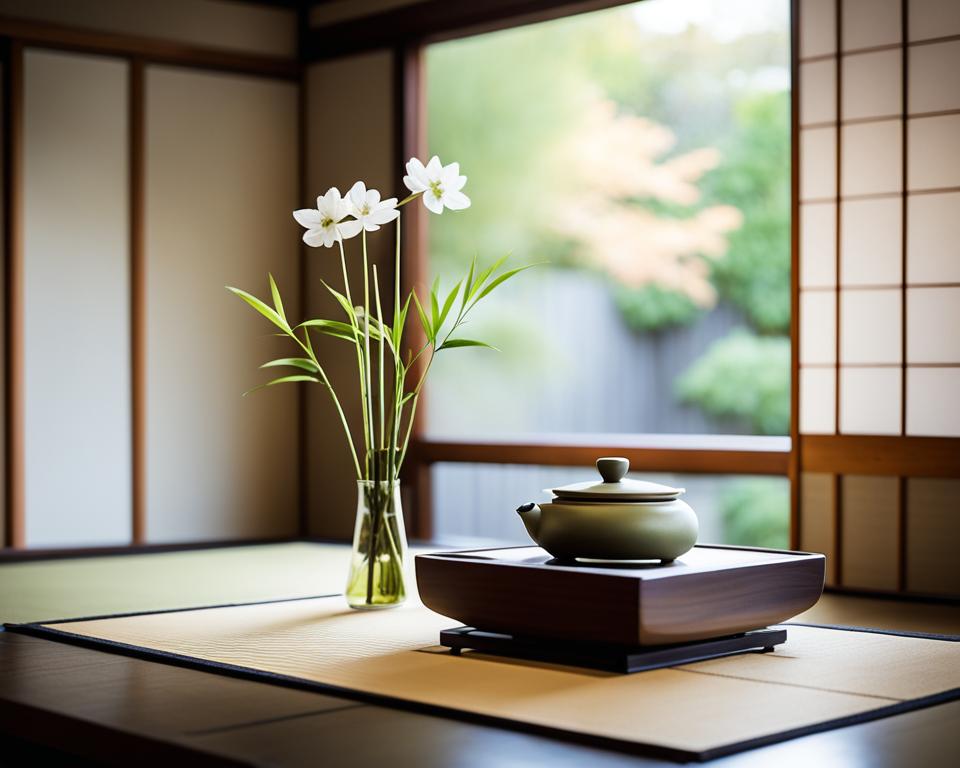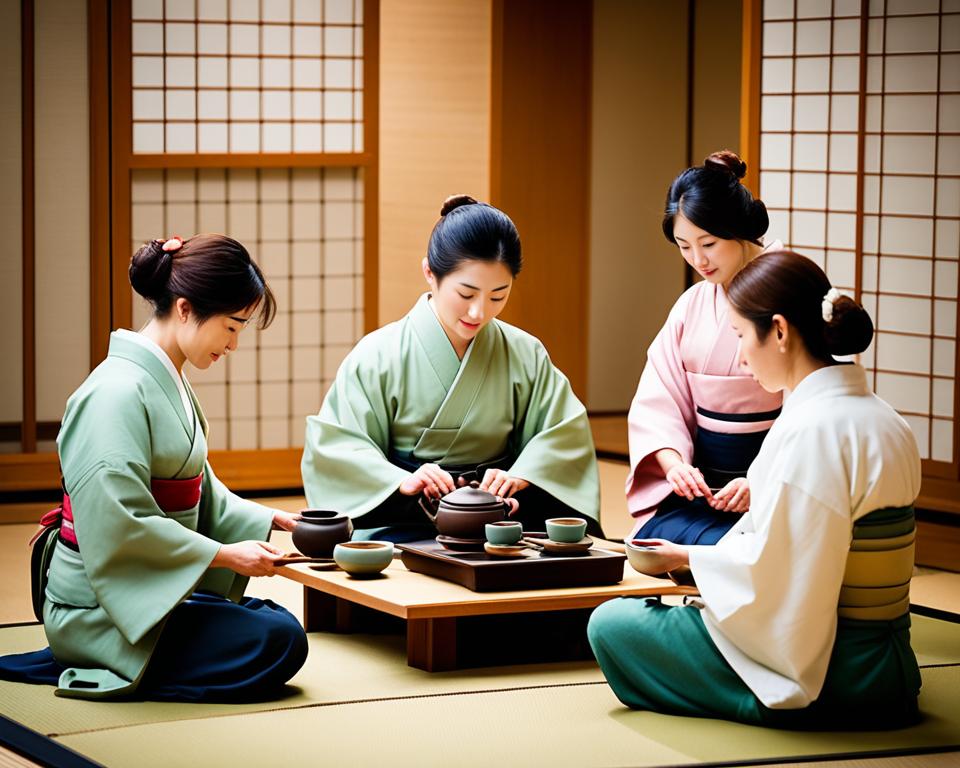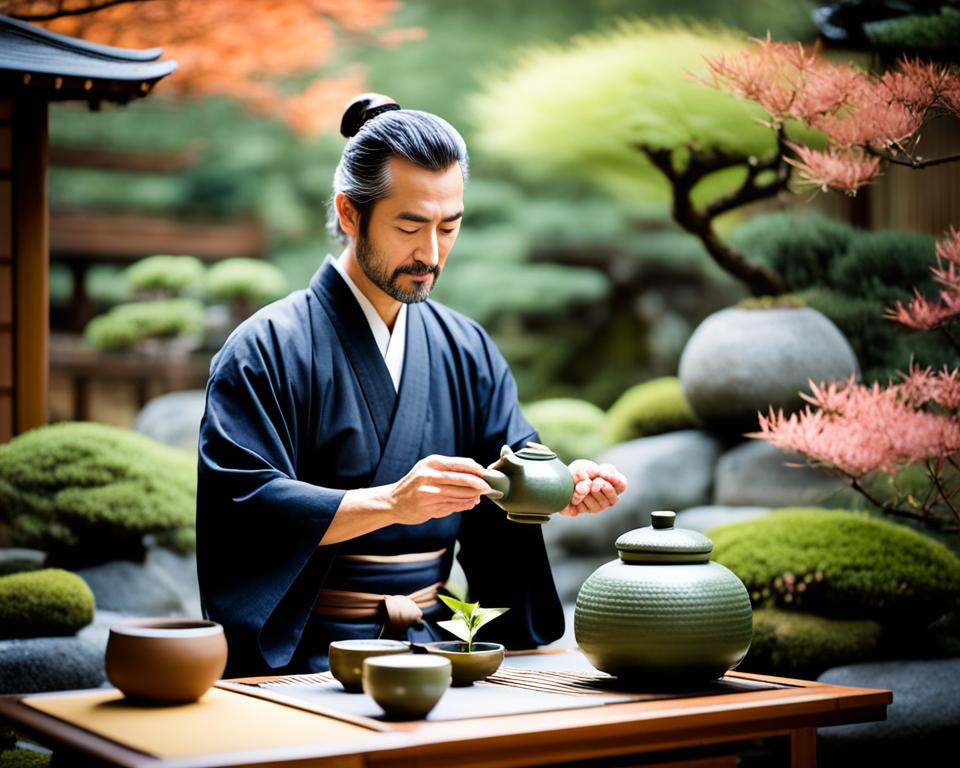The Japanese tea ceremony is called Chanoyu. It’s a centuries-old cultural practice. It makes making and serving tea into a special ritual. This ritual brings harmony and deeper meaning to those who take part. It’s based on the ideas of Zen Buddhism and the beauty of Wabi-Sabi.
This tradition combines good manners, beautiful art, and a spiritual experience. Every step of the ceremony is done with great care. It shows respect for guests, nature, and the moment. By participating, people feel a sense of peace and beauty.
Read interesting things at : info-kirara
Key Takeaways
- The Japanese tea ceremony, known as Chanoyu, is a centuries-old cultural tradition.
- The tea ceremony is rooted in the principles of Zen Buddhism and the aesthetic philosophy of Wabi-Sabi.
- The tea ceremony is a harmonious blend of refined etiquette, exquisite artistry, and profound spirituality.
- The tea ceremony elevates the simple act of preparing and serving tea into a meaningful ritual.
- The Japanese tea ceremony is a captivating and timeless cultural tradition.
Japanese Tea Ceremony: A Captivating Cultural Tradition
The Japanese tea ceremony, also known as Chanoyu, has a long history. It started in the 12th century, showing the Zen Buddhist ideas and love for nature. Early tea masters, like Sen no Rikyū, followed the Zen path, valuing mindfulness, simplicity, and the beauty of imperfection called Wabi-Sabi.
Origins and History of Chanoyu
Chanoyu, or the Way of Tea, began in the 12th century, blending with Zen Buddhist values of unity and enjoying the moment. This timeless tradition has been handed down over the years, keeping its hold on people’s hearts.
Philosophical Underpinnings: Zen Buddhism and Wabi-Sabi
The Chanoyu tradition honors Zen Buddhism and Wabi-Sabi. Zen focuses on being fully present, simplicity, and appreciating the flaw. These influences make the tea ceremony a peaceful and nature-loving event.
The Japanese Tea Ceremony: A Multisensory Experience
The Japanese tea ceremony is deeply sensory, touching many senses. It uses beautiful tea utensils chosen with care. They reflect the Wabi-Sabi philosophy, finding beauty in imperfection.
Tea Utensils: Beauty in Simplicity
Every part of the ceremony shows a love for beauty. The tea bowls and scoops, the bamboo whisk, and tea caddy are all special. They’re treated like art. This shows Japan’s love for simple, yet beautiful things.
The Tranquil Tea House Setting
The ceremony happens in a special tea house called a Chashitsu. These places are meant to bring peace and harmony. They include a garden and a path of raked gravel. Inside, there’s an alcove for seasonal decorations.
Mastering the Art of Japanese Tea Ceremony
Becoming a tea master takes years of learning. Japanese tea ceremony focuses on delicate moves and beauty. You become a Chajin by mastering these.
To start, you learn about the ceremony’s history. You also explore Zen and Wabi-Sabi, key to its ritual. This knowledge helps appreciate simple beauty and flaws.
Next, tea masters perfect every step of making matcha. They know the best way to pick and set up tea items. Each item has its special story.
Finally, after much practice and mentorship, they become Chajin. These experts keep the tea ceremony’s traditions alive. It’s a title of great honor.
Tea Masters: Guardians of Chadō Traditions
The Japanese tea ceremony, called Chanoyu, is a living tradition kept alive by many generations. It’s thanks to dedicated tea masters, or Chajin, that the Way of Tea is still practiced today. They guard the ceremony’s details, from rituals to philosophy, passing it on to later generations.
Training and Dedication of Tea Masters
Becoming a tea ceremony master takes a lifetime of devotion. These masters spend years learning every detail, from the way they move to the choices they make. This commitment reflects their deep respect for the Chadō tradition.
Renowned Tea Masters Throughout History
Over time, many famous tea masters have shaped the Japanese tea ceremony. Sen no Rikyū is among the best-known, setting down many of its key principles. Today, modern tea masters keep this tradition alive by blending old practices with new ideas.
The Revered Matcha: Heart of the Japanese Tea Ceremony
The Japanese tea ceremony, or Chanoyu, centers around matcha. This finely ground green tea comes from the Camellia sinensis plant. It’s not just a drink; it’s a vibrant part of a centuries-old tradition. From its rich green color to its health benefits, matcha enriches every aspect of the ritual.
Matcha Production and Quality
Creating high-quality matcha is both an art and a science. It involves skilled farmers and specific processes. The best matcha comes from young tea leaves. These leaves are shaded before harvest. This step boosts their chlorophyll, giving matcha its signature color. After picking, the leaves go through steaming, drying, and grinding. This turns them into a fine, flavorful powder.
Health Benefits of Matcha Tea
Matcha offers more than just a delicious drink. It’s packed with antioxidants and nutrients. These can help with metabolism, brain function, and relaxation. Matcha isn’t just a key part of the tea ceremony. Its benefits add to the whole experience, making it more than just a drink.
Kaiseki Cuisine: The Culinary Companion
The Japanese tea ceremony often features Kaiseki, a many-course meal. It’s made to go along with the tea’s flavors and looks. Kaiseki brings a happy feeling of the current season. Its dishes show respect for nature’s gifts.
Seasonality and Aesthetics in Kaiseki
Kaiseki deeply respects nature’s seasons and their offerings. Every meal part highlights the best, freshest ingredients for that time. This shows our link to the natural world. The menu changes with the seasons, offering different tastes and presentations.
Kaiseki dishes are true works of art. They’re placed with care, considering color, feel, and layout. Special eating tools add to the beauty. The meal setup fits perfectly with the Japanese tea ceremony’s style.
Pairing the japanese tea ceremony with kaiseki cuisine is magical. It delights the eyes, nose, and mouth, making you feel part of a refined world. This experience is all about celebrating nature and beauty.
The Japanese Tea Ceremony: A Timeless Ritual for Modern Times
The Japanese tea ceremony roots in Zen Buddhism. It focuses on being mindful, simple, and loving nature. This makes it a lasting cultural tradition. It lets people pause in our fast world, find peace, and feel connected.
Adapting Traditions for Contemporary Life
Though the Japanese tea ceremony stayed true for ages, it’s also evolving. Now, tea masters mix old traditions with our modern, busy lives. This makes the ceremony more open and easy to relate to for many.
The Enduring Appeal of Chanoyu
The Japanese tea ceremony remains popular for its universal soothing effects. It’s a timeless refuge for peace and mindful living. As we all look for calm in a hectic world, the Chanoyu stands out. It encourages us to savor simple moments and find our own inner peace.

Tea Houses: Sanctuaries of Serenity
In Japan, you find the famous tea ceremony held in a Chashitsu, a traditional tea house. These small buildings are made to help people feel calm and at one with nature. They provide the perfect setting for the tea ceremony to be performed with beauty and meaning.
Traditional Tea House Architecture
Traditional Japanese tea houses are elegant in their simplicity. They blend functionality and beauty perfectly. You will find a beautiful garden, a neat pathway, and a special place called the Tokonoma for seasonal artwork inside. The tea house feels peaceful because it uses natural materials and soft lighting. It invites guests to reflect deeply.
Finding Authentic Tea Houses Around the World
Most authentic Japanese tea houses are in Japan’s cultural heart. But, more places worldwide are sharing this special tea house vibe. Museums, gardens, and cultural spots have built spaces that echo the peaceful Chashitsu. This means there are chances worldwide to enjoy the tea ceremony. It’s a great way to connect with a tradition that’s full of beauty and serenity.
The Way of Tea: Lessons in Mindfulness
The Japanese tea ceremony, Chanoyu, focuses on being mindful and in the present. It’s a beautiful blend of Zen principles, like having a calm mind and seeing the beauty in imperfection. It also celebrates our link with nature.
Cultivating Presence and Appreciation
Chanoyu asks its participants to leave all the world’s worries behind. They focus on the moment by carefully making and sharing tea. This helps everyone value the now and its simple yet profound beauty.
Zen Buddhism’s teachings heavily influence Chanoyu. They remind us to enjoy life’s simple, imperfect pleasures. The ceremony showcases wabi-sabi through its tea tools, humble tea houses, and respect for nature’s changes.
Through Chanoyu, people learn to be mindful and see the beauty in every moment. It’s a chance to find peace inside, connect with the natural world, and appreciate life, even when it seems fleeting and not perfect.
Cultural Significance of the Japanese Tea Ceremony
The Japanese tea ceremony is a deeply rooted cultural practice. It greatly impacts Japan’s society, touching its art and design, diplomacy, and social life. For centuries, it has been key in shaping the country’s artistic tastes and how people interact. It’s at the heart of what it means to be Japanese.
Influence on Art and Design
The graceful beauty and balance of the Japanese tea ceremony influence Japan’s art and design. Artists and architects share this tradition in their work. They use natural elements and find beauty in imperfections. The unique ceramics and simple tea house designs show how deeply this culture values the tea ceremony.
Role in Diplomacy and Social Gatherings
The Japanese tea ceremony goes beyond art. It’s also a powerful diplomatic and social tool. Its core values – harmony, respect, and sharing – have brought people together for centuries. Leaders and important figures around the world take part. They do this to show respect and to have open, meaningful conversations. This tradition strengthens bonds, making it a cornerstone of Japanese society.

Tea Ceremony Etiquette and Traditions
The Japanese tea ceremony, known as Chanoyu, is a detailed practice. It involves many steps and traditional behaviors. People must dress and act in a way that shows deep respect for the ritual.
Proper Attire and Manners
In the tea ceremony, wearing the right clothes is very important. Those taking part usually wear something formal and simple. This includes kimonos for women. Men can wear suits or Japanese outfits. The aim is to look clean and show a quiet kind of greatness.
At the tea house’s door, guests start by removing their shoes. Then, they walk slowly and quietly. They greet the host with a deep bow. During the event, everyone must follow the ceremony’s rules very carefully. This means being extra careful with the tea tools and paying close attention to what the host says or does.
Symbolism and Rituals
This ceremony is full of meaning and traditional moves. Every step, from getting the tea tools ready to how the host moves, has a purpose. It focuses on the importance of each action.
Offering the matcha tea is done with great care. The host mixes the green powder carefully, creating a frothy drink. When the tea is shared, it shows hospitality and brings everyone together.
In addition to the tea, people also admire the beauty around them. This could be a piece of calligraphy or a special flower arrangement. These details connect the ceremony to nature.
Experiencing the Japanese Tea Ceremony
Want to dive into the calm of the Japanese tea ceremony? You can do this worldwide, not just in Japan. There are various ways to get closer to this beautiful tradition.
Attending a Public Tea Ceremony
Seeing the Japanese tea ceremony up close is easy at public events. They are often at traditional tea houses or in cultural centers. Here, anyone can watch a tea master show the detailed steps of Chanoyu, the Way of Tea, when preparing and serving matcha.
Learning the Art of Chanoyu
If you want to really learn, many places offer tea ceremony classes. These courses cover everything, from how to hold tea utensils correctly to the deep meanings behind this ancient tradition. It’s a chance to become a true expert yourself.
Future of the Japanese Tea Ceremony
The Japanese tea ceremony is gaining more fans worldwide. Many are working hard to keep this ancient tradition alive. They focus on the details, beauty, and deep meanings of this practice known as the Chadō.
Preserving Ancient Practices
Keeping the tea ceremony alive faces key challenges. It takes years to become a tea master. This journey involves mastering specific moves, rules, and the look of the ceremony.
It’s vital to keep these teachings alive and find new tea masters. This is how the Japanese tea ceremony will survive for future generations.
Innovations and Adaptations
Yet, there’s also a push to make the tea ceremony appeal to today’s world. Some tea masters are mixing old traditions with new styles. They add modern looks and tech to the ceremony.
Efforts are also underway to share the ceremony with more people. Now, there are tea houses and learning programs in many nations.
The Japanese tea ceremony remains as important as ever. It gives a special way for people to find calm, beauty, and peace. Thanks to the hard work of many, its future looks bright. It will keep inspiring new folks to join in on this beautiful tradition.
